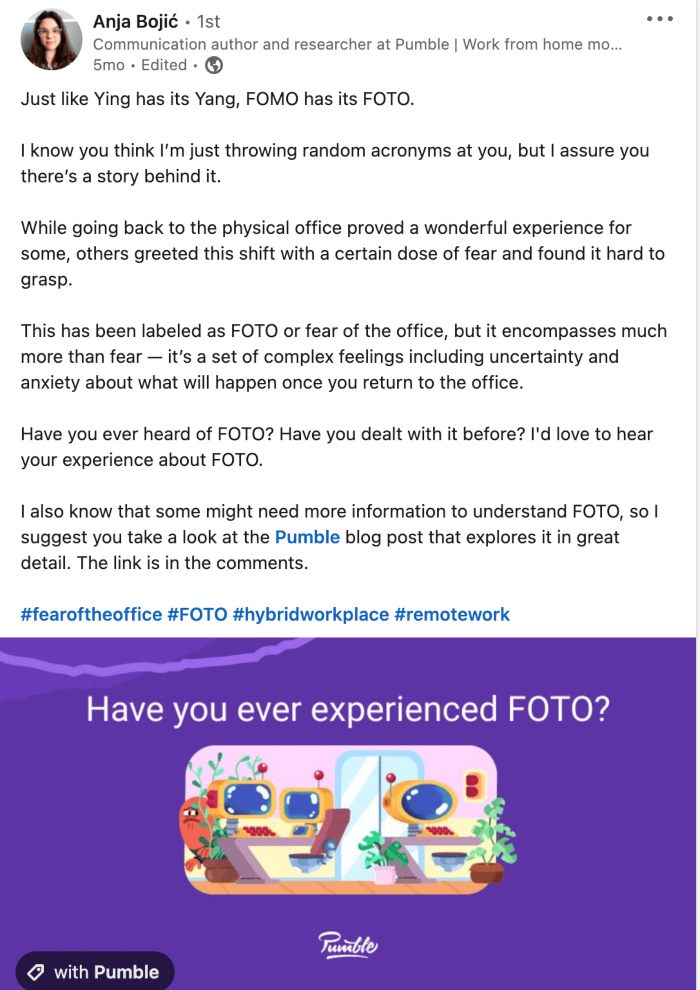Do you often find your coworkers MIA even though they said they’ll BRB?
Are you AATK, or more AAK?
Do you often use texting acronyms in business communication, or do you afraid it might be considered NSFW?
If you’re not sure whether, or how, to use texting acronyms in business, we’ve got you covered.
In this blog post, we will:
- Define texting acronyms,
- Explain the main reasons you should implement acronyms in your business communication,
- List out the acronyms most commonly used in business communication,
- Give examples of how texting acronyms can be used in different situations in business, and
- Provide etiquette rules to follow when using texting acronyms in business.
Table of Contents
What are texting acronyms?
A texting acronym is a shortened version of a word or a phrase, used predominantly in texting to save time and grab the shortened attention span of the reader.
The origin story of texting acronyms can be traced back to the early days of texting. Back then, keyboards required multiple taps to write one letter, so users had to be creative to speed up the process of texting.
Nowadays, texting acronyms are used in almost all forms of written communication, mostly for the purpose of saving time.
In the case of social media posting, for example, acronyms are used for relevance — but also to keep your posts within a certain character limit.
Although commonly used interchangeably, texting abbreviations and acronyms have one distinct difference — their form.
Abbreviations are shortened forms of words (e.g. Prof.), usually consisting of the first few letters of the word.
Acronyms, on the other hand, are words created using the first letters of the words in a phrase (e.g. USA)
Why you should use texting acronyms in business
Although they often may seem confusing, misspelled, and grammatically incorrect, texting acronyms and abbreviations — or even emojis — have almost become commonplace in today’s business communication.
In business, texting acronyms are most often associated with marketing, when brands adjust their messaging to appeal more to their target audience.
However, we can find texting acronyms and abbreviations in almost any form of written business correspondence, including:
- Conversations in team chat apps
- Emails
- Presentations
- Promotional material
- Social media posts
Although most commonly cited, the time-saving factor is not the only reason professionals use texting acronyms in business communication.
Teams and organizations may also use acronyms and abbreviations in their internal communication — to connect and communicate in a more meaningful and less formal way.
And what acronyms should you use for these purposes?
Let’s find out.
Best texting acronyms to use in business situations
Here’s a list of acronyms you can safely use in different situations in your business communication, categorized by context:
- Common SFW (safe for work) texting acronyms
- General business texting acronyms
- Marketing texting acronyms
- IT acronyms commonly used in business
Common SFW (safe for work) texting acronyms
Common SFW (i.e. safe for work) texting acronyms include the following acronyms.
| Acronym | Meaning | Used when… | |
|---|---|---|---|
| 1. | ALOL | Actually laughing out loud | Something is actually funny |
| 2. | ADN | Any day now | You want to be vague in your status updates |
| 3. | BTW | By the way | You want to gracefully change the subject of conversation |
| 4. | B4 | Before | You’re too lazy to type ‘before’ |
| 5. | FOMO | Fear of missing out | You’re late to the office party |
| 6. | FOTO | Fear of the office | You don’t want to go to the office party |
| 7. | FTFY | Fixed that for you | Your coworker asks for a favor and you deliver |
| 8. | GR8 | Great | You want to praise a coworker for a job well done |
| 9. | HBU | How about you? | You’re catching up with your work bestie |
| 10. | HF | Have fun | Your coworker goes on vacation |
| 11. | IDK | I don’t know | You can’t decide what to order for lunch |
| 12. | IMO | In my opinion | You want to respect your coworkers’ feelings when giving feedback |
| 13. | IRL | In real life | You’re planning to meet with your teammates in person |
| 14. | JK | Just kidding | You send a risky meme in your team chat |
| 15. | K | Okay | You want to agree or acknowledge someone’s opinion, and end the conversation |
| 16. | L8R | Later | You’re muting your team chat to focus on your work |
| 17. | LMK | Let me know | You’re asking for feedback |
| 18. | LOL | Laughing out loud | Something is not necessarily funny, but you want to be nice |
| 19. | NVM | Nevermind | You’ve found the solution yourself after asking your coworkers for help |
| 20. | PLS/PLZ | Please | You beg your work bestie to go to the company workshop with you |
| 21. | POV | Point of view | You want to appear relatable in your social media posts |
| 22. | RN | Right now | You want to update your team on your progress or state in real-time |
| 23. | RT | Roger that | Your boss gives you a long list of tasks they want you to do |
| 24. | TGIF | Thank god it’s Friday | It’s been a long week |
| 25. | TL;DR | Too long didn’t read | You write a 200-word DM and realize no one is going to read it in full |
| 26. | TMI | Too much information | You overshared in a team chat |
| 27. | TMRW | Tomorrow | You’re putting off a task you hate |
| 28. | W/O | Without | You can’t type ‘without’ |
| 29. | W8 | Wait | You’re busy but you also want to reply to a DM |
| 30. | YT | You there? | It’s clear they’re not there |
💡 Pumble Pro Tip
Want to learn more about FOTO and FOMO in hybrid work settings? Check out our guide on the blog:
General business texting acronyms
General business texting acronyms include the following acronyms.
| Acronym | Meaning | |
|---|---|---|
| 31. | A/N | Author’s note |
| 32. | AA | As above |
| 33. | AA | Ask about |
| 34. | AAK | Asleep at keyboard |
| 35. | AAMOF | As a matter of fact |
| 36. | AAMOI | As a matter of interest |
| 37. | AAP | Always a pleasure |
| 38. | AAR | At any rate |
| 39. | AATK | Always at the keyboard |
| 40. | AC | Acceptable content |
| 41. | ADAD | Another day, another dollar |
| 42. | ADD | Address |
| 43. | AEAP | As early as possible |
| 44. | AFK | Away from keyboard |
| 45. | AKA | Also known as |
| 46. | ASAP | As soon as possible |
| 47. | ATB | All the best |
| 48. | ATM | At the moment |
| 49. | AYEC | At your earliest convenience |
| 50. | AYT | Are you there? |
| 51. | B2B | Business-to-business |
| 52. | B2C | Business-to-consumer |
| 53. | B2W | Back to work |
| 54. | B | Back |
| 55. | BAK | Back at keyboard |
| 56. | BAU | Business as usual |
| 57. | BFAW | Best friend at work |
| 58. | BIF | Before I forget |
| 59. | BOGO | Buy one get one (free) |
| 60. | BRB | Be right back |
| 61. | BRT | Be right there |
| 62. | BYOC | Bring your own computer |
| 63. | BYOD | Bring your own device |
| 64. | C2C | Customer to customer |
| 65. | COB | Close of business |
| 66. | DIY | Do it yourself |
| 67. | DM | Direct message |
| 68. | DND | Do not disturb |
| 69. | EOD | End of day |
| 70. | ETA | Estimated time of arrival |
| 71. | F2F | Face to face |
| 72. | FW | Forward |
| 73. | FYI | For your information |
| 74. | ICYMI | In case you missed it |
| 75. | IIRC | If I recall correctly |
| 76. | IM | Instant message |
| 77. | JIC | Just in case |
| 78. | KOL | Key opinion leader |
| 79. | KPI | Key performance indicator |
| 80. | MGMT | Management |
| 81. | MSG | Message |
| 82. | MMS | Multimedia messaging service |
| 83. | N/A | Not applicable or not available |
| 84. | NP | No problem |
| 85. | NSFW | Not safe/suitable for work |
| 86. | OOO | Out of office |
| 87. | PIN | Personal identification number |
| 88. | PSA | Public service announcement |
| 89. | PTO | Personal/Paid time off |
| 90. | QC | Quality control |
| 91. | RFP | Request for proposal |
| 92. | ROI | Return on investment |
| 93. | SMB | Small to midsize business |
| 94. | SME | Subject matter expert |
| 95. | SMS | Short message service (text message) |
| 96. | T&C | Terms and conditions |
| 97. | TBA | To be announced |
| 98. | TBD | To be determined |
| 99. | TBH | To be honest |
| 100. | TYT | Take your time |
| 101. | VAT | Value added tax |
| 102. | VIP | Very important person |
| 103. | WDYM | What do you mean |
| 104. | WFH | Work from home |
| 105. | WIP | Work in progress |
Marketing texting acronyms
Marketing texting acronyms include the following acronyms.
| Acronym | Meaning | |
|---|---|---|
| 106. | CMS | Content management system |
| 107. | CPC | Cost per click |
| 108. | CPM | Cost per mile (thousand) |
| 109. | CR | Conversion rate |
| 110. | CTA | Call to action |
| 111. | CTR | Click-through rate |
| 112. | CX | Customer experience |
| 113. | FAQ | Frequently asked questions |
| 114. | FB | |
| 115. | IG | |
| 116. | LI | |
| 117. | MLM | Multi-level marketing |
| 118. | QOTD | Quote of the day |
| 119. | SEM | Search engine marketing |
| 120. | SEO | Search engine optimization |
| 121. | SERP | Search engine results page |
| 122. | SMM | Social media marketing |
| 123. | SMO | Social media optimization |
| 124. | UGC | User-generated content |
| 125. | UI | User interface |
| 125. | UX | User experience |
| 127. | YT | YouTube |
IT acronyms commonly used in business
IT acronyms commonly used in business include the following acronyms.
| Acronym | Meaning | |
|---|---|---|
| 128. | RSS | Rich site summary |
| 129. | SaaS | Software as a service |
| 130. | VoIP | Voice over Internet protocol |
| 131. | HTML | Hypertext markup language |
| 132. | P2P | Peer-to-peer |
| 133. | PKI | Public key infrastructure |
| 134. | URL | Uniform resource locator |
How to use texting acronyms in business — text acronyms examples
Although texting acronyms have become common in business communication, it doesn’t necessarily mean you should use them in all situations and to any extent.
There are some instances where it might still be more appropriate to use the original forms of words and phrases.
At the same time, certain communication situations and formats almost require using acronyms.
For example, you can hardly imagine a social media post or team conversations in team chat apps, for example, without an acronym or two.
Here are some examples of how texting acronyms can fit naturally in your business writing to help you better understand texting acronym etiquette in business communication.
Text acronyms examples for team chat app conversations
In most cases, your team chats fall into the category of semi-formal communication.
You don’t necessarily need to lose all inhibitions and make inappropriate jokes in your team chat threads.
However, a few tasteful acronyms here and there are almost necessary for those moments when you want to loosen up and build more authentic relationships with your coworkers.
Acronyms and abbreviations fit into these chats perfectly for several reasons:
- They allow for less formal communication between teammates.
- They facilitate faster and more efficient communication which speeds up decision-making and problem-solving in a team.
- They help teammates build better relationships by communicating in a more natural way.
Here’s an example of a person using an acronym to explain their absence to their team quickly.
Marie wants to let their team know they will be away for a few short minutes, in case anyone needs them during that period. Instead of using the complete sentence to explain they will be right back, Marie uses a commonly used acronym:

Text acronyms examples for social media posts
Whether you want to appeal to your audience or simply need to keep your post within a certain character limit, you’ll use acronyms in your social media posts.
From TB (throwback) posts and hashtags to FOMO and WFH relatable videos, there are plenty of ways businesses use acronyms in their social media strategy.
This is an example of how acronyms can be used in a LinkedIn post.

Text acronyms examples for customer service chats
Being on the front lines of problem-solving, customer support teams use acronyms and abbreviations in their communication with customers to both ensure faster response times and achieve a more natural tone of voice.
Here is an example of a message from a customer service chat:
Hi!
Thanks for contacting us.
We’ve received your message and appreciate you reaching out.
One of our support specialists will reach out to you ASAP.
In the meantime, feel free to check out our FAQ.
Text acronyms examples for out-of-office emails
While you may not want to go overboard with lesser-known acronyms in official emails, you can be more creative and fun in your out-of-office messages.
Here’s an example of an out-of-office autoresponder message containing two widely used and easy-to-decode acronyms:
Hello, and thanks for your email.
I’m currently OOO until September W/O access to email.
If your request is urgent, please contact Jane Smith at janesmith@mail.com
I’ll be sure to get back to you when I return in September.
Best.
Text acronyms examples for promotional emails/SMS texts
Promotional SMS texts and emails pioneered acronym usage decades ago.
Brands and businesses wanting to make their messaging more relatable turn to popular texting acronyms and abbreviations used by their target audience.
Here’s an example of how brands can incorporate acronyms in their promotional emails and SMS texts:
ICYMI, our summer sale has been extended until the end of August!
Hurry up and grab your favorite items for up to 60% off.
Business texting acronyms DOs and DON’Ts
Now that we have a better understanding of the best texting acronyms to use in business, let’s go over some of the most important tips on how to use texting abbreviations and acronyms in business.
And also, how NOT to use them.
DO Mind your audience
Whether you’re preparing a marketing strategy for a beauty brand with a casual brand voice or writing a formal project proposal, your first step is understanding your audience — i.e. the people your writing addresses.
As acronyms and abbreviations are mostly considered informal or semi-formal, you’d want to pay attention to the type and volume of acronyms you use, depending on the type of written message and the audience you’re addressing.
For example, if you’re writing an email to a senior partner at your company, you may want to lose the acronyms altogether. Or, stick to the well-known unambiguous acronyms frequently used in business communication — to make sure you’re not sending the wrong message and making the wrong impression.
At the same time, acronyms are almost mandatory if you’re writing a caption for a TikTok video, for instance. The audience on TikTok and social media, in general, is more familiar with popular abbreviations and acronyms, which makes your messaging more relevant and relatable.
Lecturer of Marketing at Coastal Carolina University, Matthew A. Gilbert, highlights context and audience as key factors when using texting acronyms in business:

“Avoid texting acronyms with formal internal or external messages using your organization’s internal IT systems. Texting acronyms are only appropriate for messages sent between colleagues using iMessage, text, or another peer-to-peer service that is separate from their organization. However, it is reasonable to use texting acronyms on internal platforms for team collaboration such as Pumble, but users must keep their use of texting acronyms professional and used only within the context of business purposes. Personal conversations should remain private, even those that might be business related.”
DON’T overuse acronyms
When you want to incorporate texting acronyms into your business writing, be sure not to overdo it.
Texting acronyms, like industry jargon, should be used sparingly — unless you want to completely confuse and alienate your audience or recipients of your messages.
Regardless of who your target audience may be, it may get confusing for the recipient to decipher your messages if every other word is an acronym or abbreviation. Especially if you use too many niche and uncommon acronyms.
To ensure you stay on the safe side, try to limit your acronyms to one or two generally accepted and familiar acronyms per message. That way, you can achieve your goal without overwhelming your readers and recipients.
DO stay professional
Whether you’re chatting with your favorite coworkers in a private channel in your team chat app like Pumble or writing a formal press release, you need to keep it professional.
A good rule of thumb when using acronyms in professional communications is to stick to the familiar and well-known ones — to make sure you’re keeping it safe and business appropriate.
If you’re not sure the acronym or abbreviation has another meaning, it’s better not to use it altogether than to risk coming across as offensive or unprofessional.
Associate Director of Communications at SUNY Oneonta, Kimberly (Sarles) MacLeod, APR, shares a similar opinion. She points out the importance of keeping all of your work messages professional:

“The best rule in texting with colleagues is to keep it as polished as possible but convey that information concisely. That may mean using an acronym, but with thought. Well-known abbreviations are okay if they are familiar. You don’t want your boss looking up something on the Urban Dictionary to decipher your message. Use acronyms as appropriate, as long as they make sense, and sparingly.”
DON’T follow trends blindly
People often want to appear cool and edgy so they try to incorporate the latest trendy acronyms in all of their messages.
This may sound like a great idea if you’re a social media manager, looking to get some quick, temporary wins.
In reality, these types of messages achieve the opposite effect in most cases. Popular acronyms and abbreviations quickly go out of style, and you risk sounding like a try-hard — and even unprofessional and offensive if you accidentally step into slang.
Moreover, trends are inherently subjective, which makes it even more difficult to get them right every time — especially if you don’t know your audience like the back of your hand.
Instead, it’s more reasonable to stick to the standard unambiguous acronyms and abbreviations commonly used in business communication — to ensure you’re always getting the right message across to your audience.
DO mind the spelling
One of the common risks of using acronyms is that it’s so easy to make a tiny typo and get an entirely different meaning than what you originally intended.
Just as an example, it would probably create a lot of confusion if you accidentally type COD (cash on delivery), instead of COB (close of business).
Make sure to always double-check before hitting “send” — to avoid awkward misunderstandings.
DON’T abbreviate words of appreciation
Kindness, common courtesy, and gratitude shouldn’t be abbreviated. TY just doesn’t come across as sincere as ‘Thank you’.
No matter how strapped for time you may be, take an additional minute to express your appreciation and gratitude appropriately.
Why?
Well, expressing gratitude the right way is a small gesture that goes a long way in terms of strengthening customer relationships or building better team relationships.
💡 Pumble Pro Tip
Want to know more about expressing gratitude in different ways and situations professionally?
Check out our guide on the blog:
Boost and streamline your business communication with Pumble
Acronyms are all about streamlining communication and saving time — and so is Pumble, a team communication app.
With its features such as channels and direct messages, Pumble helps you achieve efficient communication and better collaboration with your colleagues. Furthermore, Pumble’s guest access allows you to invite and interact with your clients or external partners.
Pumble also helps you display availability — instead of sending those pesky OOO emails, you can just change your availability status when you’re on your PTO.

With Pumble, the collaboration never stops — nor does it expire. Thanks to the unlimited message history, you can always find old conversations or files you shared with anyone in your organization.




